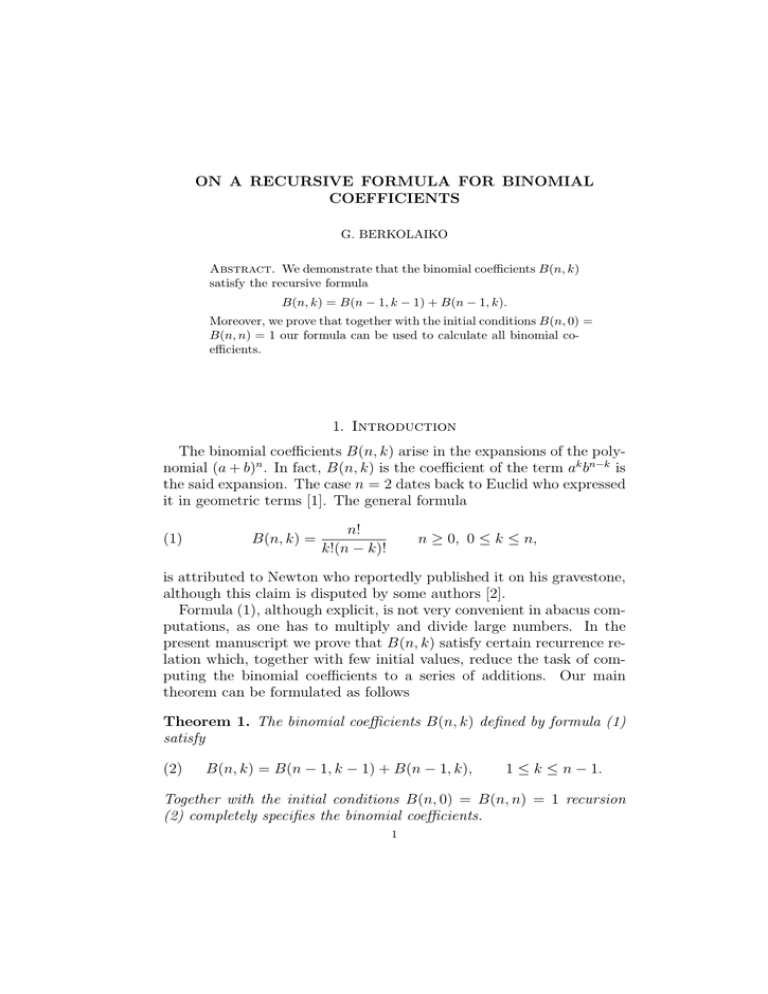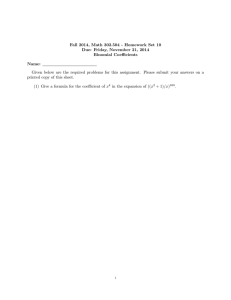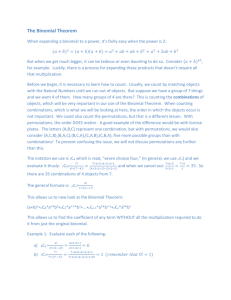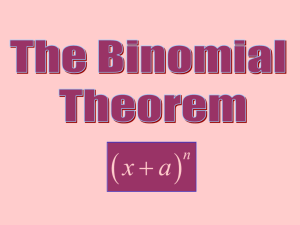ON A RECURSIVE FORMULA FOR BINOMIAL COEFFICIENTS
advertisement

ON A RECURSIVE FORMULA FOR BINOMIAL COEFFICIENTS G. BERKOLAIKO Abstract. We demonstrate that the binomial coefficients B(n, k) satisfy the recursive formula B(n, k) = B(n − 1, k − 1) + B(n − 1, k). Moreover, we prove that together with the initial conditions B(n, 0) = B(n, n) = 1 our formula can be used to calculate all binomial coefficients. 1. Introduction The binomial coefficients B(n, k) arise in the expansions of the polynomial (a + b)n . In fact, B(n, k) is the coefficient of the term ak bn−k is the said expansion. The case n = 2 dates back to Euclid who expressed it in geometric terms [1]. The general formula (1) B(n, k) = n! k!(n − k)! n ≥ 0, 0 ≤ k ≤ n, is attributed to Newton who reportedly published it on his gravestone, although this claim is disputed by some authors [2]. Formula (1), although explicit, is not very convenient in abacus computations, as one has to multiply and divide large numbers. In the present manuscript we prove that B(n, k) satisfy certain recurrence relation which, together with few initial values, reduce the task of computing the binomial coefficients to a series of additions. Our main theorem can be formulated as follows Theorem 1. The binomial coefficients B(n, k) defined by formula (1) satisfy (2) B(n, k) = B(n − 1, k − 1) + B(n − 1, k), 1 ≤ k ≤ n − 1. Together with the initial conditions B(n, 0) = B(n, n) = 1 recursion (2) completely specifies the binomial coefficients. 1 2 G. BERKOLAIKO 2. Proof of the main result Proof. Using equation (1) we obtain (n − 1)! (n − 1)! 1 = , (k − 1)!(n − k)! (k − 1)!(n − k − 1)! n − k (n − 1)! (n − 1)! 1 B(n − 1, k) = = . k!(n − k − 1)! (k − 1)!(n − k − 1)! k B(n − 1, k − 1) = Adding the two together we calculate (n − 1)! 1 1 B(n − 1, k − 1) + B(n − 1, k) = + (k − 1)!(n − k − 1)! n − k k (n − 1)! n = (k − 1)!(n − k − 1)! k(n − k) n! = k!(n − k)! = B(n, k). This proves recursion (2). We notice that the right-hand side of (2) only makes sense when 1 ≤ k ≤ n − 1, since the original binomial B(n, k) is only defined when 0 ≤ k ≤ n. To demonstrate that the above recursion fully specifies the binomial coefficients when supplemented with the initial conditions B(n, 0) = B(n, n) = 1 we employ induction on n. For n = 0 and n = 1 all the binomial coefficients are specified by the initial data: B(0, 0) = 1, B(1, 0) = 1, B(1, 1) = 1. Assume all values for n = N − 1 have been found. Then we can find values of B(N, k) for k = 1, . . . , N − 1 from the recursion. For the remaining values of k, k = 0 and k = N , the values are again given by the initial data: B(N, 0) = 1, B(N, N ) = 1. This completes the proof of the theorem. 3. Conclusions and Outlook We have shown that the binomial coefficients satisfy a recurrence relation which can be used to speed up abacus calculations. Our approach raises an important question: what can be said about the solution of the recurrence (2) if the initial data is different? For example, if B(n, 0) = 1 and B(n, n) = −1, do coefficients B(n, k) stay bounded for all n and k? ON A RECURSIVE FORMULA FOR BINOMIAL COEFFICIENTS 3 Acknowledgment Useful discussions with B. Pascal regarding arrangements of B(n, k) in a hexagonal pattern are gratefully acknowledged. References [1] Euclid, Elements, 34th ed., Macedonian Press, Thebes, 1976. [2] F. Cajori, Was the binomial theorem engraven on Newton’s monument?, Bull. Amer. Math. Soc. 1 (1894), 52–54 . Department of Mathematics, Texas A&M University, College Station, TX 77845-3368, U.S.A.








